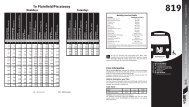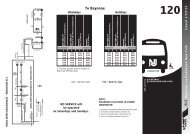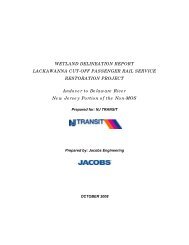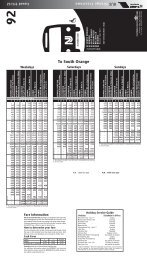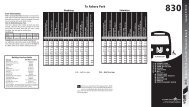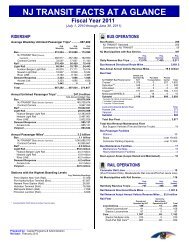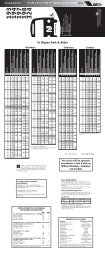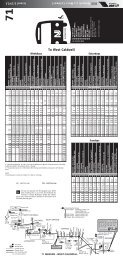APPENDIX L: Endangered Species Technical Report - New Jersey ...
APPENDIX L: Endangered Species Technical Report - New Jersey ...
APPENDIX L: Endangered Species Technical Report - New Jersey ...
Create successful ePaper yourself
Turn your PDF publications into a flip-book with our unique Google optimized e-Paper software.
<strong>New</strong> <strong>Jersey</strong> – Pennsylvania Lackawanna Cut-Off Passenger Rail Service Restoration Project Environmental Assessment FINAL<br />
L.2 Impact Assessment<br />
The primary areas of concern for impacts to threatened and endangered species fall along much of the out<br />
of service portion of the corridor located in <strong>New</strong> <strong>Jersey</strong> as well as at candidate station sites and<br />
yard/maintenance facilities at various intervals along the entire study corridor. Potential impacts to<br />
critical habitat may be associated with the clearing of vegetation and earth moving construction required<br />
for installing new track along the corridor and at candidate station sites as well as rehabilitation and<br />
construction of existing concrete bridge and culvert structures. While it is highly probable that wildlife<br />
cross or travel along the corridor on various foraging or breeding migrations, it will not create any more<br />
of a physical barrier than already exists given the extensive cut and fill embankments. Reactivation of rail<br />
service may however attribute to habitat fragmentation for those species which are sensitive to noise.<br />
L.2.1 US Department of the Interior – Fish and Wildlife Service<br />
The <strong>Endangered</strong> and Nongame <strong>Species</strong> (ENSP) program has undertaken special effort to identify, protect<br />
and conserve (in conjunction with the <strong>New</strong> <strong>Jersey</strong> Green Acres Program) Bog Turtle habitat areas. ENSP<br />
performed an extensive survey of Bog Turtle habitat from 1993 to 1999 to identify confirmed and<br />
potential habitat for bog turtles. The habitat areas were ranked as to their suitability to provide habitat for<br />
large populations of turtles that could potentially move from one wetland complex/stream corridor to<br />
another to facilitate breeding. This also helps to prevent inbreeding depression and susceptibility to<br />
episodic disease and environmental stress. Many bog turtle habitat corridors are fragmented by<br />
development and this has been the leading factor in the decline of populations. Invasive non-native plant<br />
species and cattle grazing have also been a factor in the loss of habitat for the turtles. Maintenance of<br />
corridors between habitats is a priority for the preservation of bog and wood turtle habitats. Initial<br />
evidence indicates that bog turtles will use drainage culverts to cross beneath roadways and rail corridors<br />
if they are available.<br />
To determine if proposed activities may adversely affect bog turtles in <strong>New</strong> <strong>Jersey</strong>, the following<br />
information will be provided to the <strong>New</strong> <strong>Jersey</strong> and Pennsylvania field offices of the Fish and Wildlife<br />
Service as required by the agencies:<br />
A survey of wetland habitats along the entire project area will be conducted during preliminary<br />
engineering. The survey results should include a United States Geologic Surveys (USGS) topographic<br />
map indicating the location of the project area and location of wetlands; color photographs of the<br />
wetlands; surveyor’s name; date of survey; and a description of the hydrology, soils and vegetation. The<br />
submission will also include:<br />
Information of the proposed impacts/widening of any rights-of-ways adjacent to the wetlands<br />
throughout the project area.<br />
A cross-section of the rights-of-way indicating existing, proposed and temporary versus permanent<br />
rights-of-way.<br />
Information on alternatives that may have been considered.<br />
The information above will be submitted to the Fish and Wildlife Service to determine if further<br />
consultation pursuant to Section 7(a)(2) of the <strong>Endangered</strong> <strong>Species</strong> Act of 1973 is required. In<br />
accordance with Section 7(a)(2), an assessment of potential direct, indirect and cumulative impacts is<br />
required for all federal actions that may affect listed species. If bog turtles are present on the project site,<br />
the Service must also be consulted to ensure that project activities will not adversely impact the bog turtle.<br />
Also, pursuant to Section 7(d), once consultation has been initiated, the federal agency and the<br />
permit/license applicant shall not make any irreversible or irretrievable commitment of resources with<br />
NJ TRANSIT June 2008<br />
L-9




